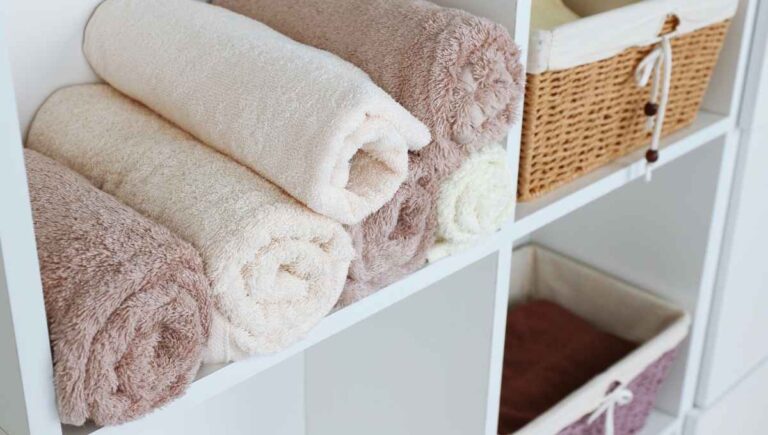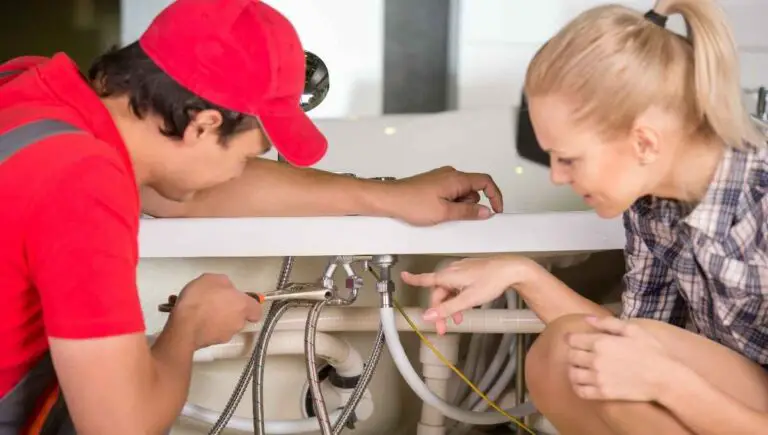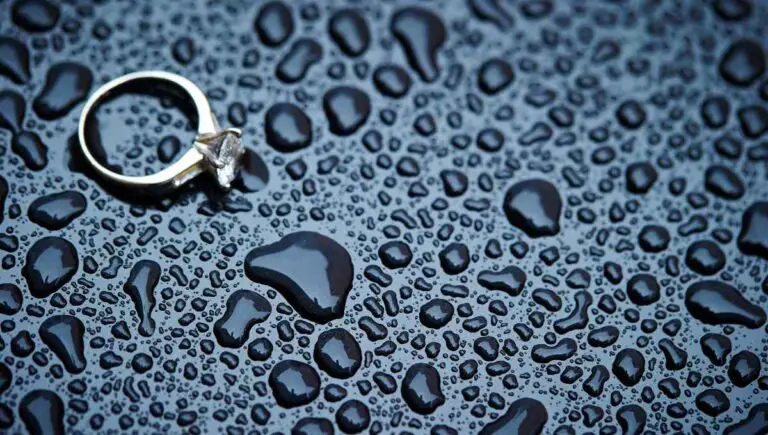Can You Flush Food Down the Toilet? (Read Before Flushing)

While it may be tempting to dispose of food scraps down the toilet, it’s important to know whether this is a safe and appropriate method of disposal. After all, the last thing you want is a clogged toilet or plumbing system. So, can you flush food down the toilet?
You should never flush food down the toilet, as it can cause serious damage to your plumbing system and lead to costly repairs. Food scraps can get caught in pipes, causing blockages that can be difficult to remove. Additionally, food waste can contribute to clogs in municipal sewer systems, leading to environmental damage and public health risks.
So, if you’re someone who’s been tempted to dispose of food scraps down the toilet, you’ll want to keep reading to learn more about the potential risks and alternative methods of disposal that are safer for your plumbing system and the environment.
This post contains affiliate links. This means Household Blogger may earn a commission should you make a purchase using any of our links. Please refer to our full affiliate disclosure policy for full details.
Here’s a Quick Pro Tip!
Here are some of our recommended garbage disposal units available on Amazon:
1. InSinkErator Evolution Excel – A high-end option with powerful performance.
2. Waste King L-8000 – A best-selling and affordable choice with a lifetime warranty.
3. Moen GXS75C – A compact and quiet unit that’s perfect for smaller households.
Understanding the Risks and Benefits of Flushing Food Waste
This section will discuss the risks and benefits of flushing food waste. One-third of all food produced globally ends up in landfills or incinerators, and flushing it down the toilet or sink may seem like a convenient way to dispose of it. However, there are potential health and environmental hazards associated with this method.
We will examine these risks and the advantages flushing food waste may offer in terms of convenience and waste reduction. By understanding these factors, we can make informed decisions about how to dispose of our food waste safely and sustainably.
What are the potential risks of flushing food waste down the toilet?
When it comes to disposing of food waste, the toilet might seem like a quick and convenient option, especially if you’re in a hurry. However, flushing food waste down the toilet can have significant negative consequences. Here are some potential risks to consider:
- Clogging of plumbing systems: Food waste, especially fibrous or starchy foods, can easily clog your plumbing systems. When you flush food down the toilet, it can get stuck in the pipes or drains, leading to blockages that can cause backups and overflows. This can be messy and expensive to repair, especially if you need to call in a plumber to unclog the pipes.
- Damage to septic systems: If you have a septic system, flushing food waste down the toilet can also harm your system. Solid waste that’s not designed to be broken down by your septic system can fill up your septic tank quickly, leading to a need for more frequent pumping. Additionally, if the food waste is not biodegradable, it can lead to clogs or damage to your drain field, which can be expensive to repair or replace.
- Potential health hazards: Flushing food waste down the toilet can also create potential health hazards. The food waste can attract rodents or other pests, which can carry diseases and pose a risk to your health. Additionally, if you flush food waste that’s contaminated with pathogens like E. coli or salmonella, it can contaminate your local water supply, posing a health risk to others in your community.
It’s important to consider the potential risks and dispose of food waste more appropriately, such as composting or throwing it in the trash.
Are there any benefits to flushing food waste down the toilet?
Flushing food waste down the toilet might seem convenient, especially if you’re in a hurry or don’t have access to other disposal options. One of the main benefits of flushing food waste down the toilet is convenience. Additionally, if you’re in a small space or don’t have a lot of storage, flushing food waste down the toilet can help you avoid accumulating excess waste.
Another potential benefit of flushing food waste down the toilet is reducing the amount of waste that goes to landfills. Landfills are already overflowing with waste, and food waste is one of the largest contributors to landfill waste. By flushing food waste down the toilet, you’re diverting it from the landfill and potentially reducing your environmental impact.
However, it’s important to consider the potential risks and negative consequences of flushing food waste down the toilet before deciding. Convenience and reduced landfill waste may seem like benefits, but they don’t necessarily outweigh the potential risks of clogging plumbing systems, damaging septic systems, or creating health hazards.
Prices pulled from the Amazon Product Advertising API on:
Product prices and availability are accurate as of the date/time indicated and are subject to change. Any price and availability information displayed on [relevant Amazon Site(s), as applicable] at the time of purchase will apply to the purchase of this product.
In most cases, it’s recommended to dispose of food waste more appropriately, such as composting or throwing it in the trash.
Understanding the impact of food waste on plumbing systems
Plumbing systems are designed to remove wastewater from homes and businesses through a pipe network that ultimately leads to municipal wastewater treatment plants. For plumbing systems to work effectively, it is important that they are used in a way that is consistent with their intended purpose.
Unfortunately, many people are unaware that they are doing things that could harm their plumbing systems. In fact, food waste is one of the most common causes of plumbing problems.
When flushed down the toilet, food waste can cause clogs and backups in the pipes. This is because food waste does not break down as easily as toilet paper and other materials that are designed to be flushed down the toilet. Over time, food waste can accumulate in the pipes and cause serious blockages.
The impact of food waste on plumbing systems can be severe. Clogs and backups can cause toilets to overflow, which can result in water damage to floors, walls, and other surfaces. In addition, clogs and backups can cause wastewater to back up into sinks and showers, which can create unpleasant and unsanitary conditions.
Moreover, when flushed down the toilet, food waste can also cause problems at wastewater treatment plants. Treatment plants are designed to remove contaminants from wastewater before it is released into the environment.
However, large amounts of food waste in the wastewater can overload the treatment plant’s capacity and prevent it from functioning properly. This can result in untreated wastewater being released into local waterways, harming aquatic ecosystems and creating public health hazards.
You might also enjoy our post on Can You Flush Baby Wipes Down the Toilet?
Types of Food That Can Be Flushed Down the Toilet
When it comes to disposing of food waste, many people wonder whether they can flush certain types of food down the toilet. While it may seem like a convenient way to get rid of leftovers or scraps, flushing the food down the toilet can actually cause serious plumbing problems and harm the environment.
In this section, we’ll take a closer look at the types of food that can be safely flushed down the toilet and the ones that should always be disposed of in other ways.
What types of food can be safely flushed down the toilet?
While it is generally not recommended to flush food down the toilet, a few types of food can be safely disposed of in this way. These include water-soluble foods and small food particles.
Water-soluble foods are those that dissolve easily in water, making them less likely to cause clogs and backups in plumbing systems. Examples of water-soluble foods include cooked vegetables, soft fruits, and grains such as rice or oatmeal.
These foods can be flushed down the toilet in small amounts without causing significant harm to plumbing systems.
Small food particles are another type of food that can be safely flushed down the toilet. This includes things like coffee grounds, tea leaves, and small bits of eggshells. These items are small enough to pass through pipes without causing significant blockages.
However, even with these types of food, it is important to use caution when flushing them down the toilet. It is always best to dispose of food waste in the trash or compost bin whenever possible, as this is a safer and more environmentally-friendly option.
Understanding which types of food should not be flushed down the toilet
While a few types of food can be safely flushed down the toilet, many more should never be disposed of in this way. Some of the most common types of food that should not be flushed down the toilet include fats, oils, grease, and large food particles.
Fats, oils, and grease, collectively known as FOG, are particularly problematic when flushed down the toilet. These substances can quickly solidify and cause blockages in plumbing systems, leading to costly repairs and potential health hazards.
Examples of FOG include cooking oil, butter, and animal fat, all of which should be disposed of in the trash or recycled if possible.
In addition to FOG, large food particles should also be avoided when flushing food waste down the toilet. Items such as bones, vegetable peels, and fruit pits are too large to pass through plumbing systems and can cause blockages and backups.
These types of food waste should be disposed of in the trash or compost bin instead.
It is important to note that even small amounts of these types of food waste can cause problems when flushed down the toilet. To avoid plumbing issues and protect the environment, it is best to dispose of food waste in other ways whenever possible.
Alternatives to flushing food waste down the toilet
Now that we’ve discussed which types of food can and cannot be safely flushed down the toilet, it’s important to explore alternative methods for disposing of food waste. There are several options available, including composting, using garbage disposal units, and simply throwing food waste in the trash.
Composting is an excellent way to dispose of food waste in an environmentally-friendly manner. By composting food waste, you can create nutrient-rich soil that can be used for gardening or farming. Composting is easy to do and requires only a small amount of space.
Many cities now offer curbside composting programs, making it even easier to dispose of food waste in this way.
Garbage disposal units are another option for disposing of food waste. These units are installed in sinks and grind up food waste so that it can be easily disposed of through the plumbing system. While garbage disposals can be convenient, they can also be expensive to install and maintain.
Prices pulled from the Amazon Product Advertising API on:
Product prices and availability are accurate as of the date/time indicated and are subject to change. Any price and availability information displayed on [relevant Amazon Site(s), as applicable] at the time of purchase will apply to the purchase of this product.
Additionally, not all types of food waste can be safely disposed of in this way, so it’s important to check with your local plumbing codes before installing a garbage disposal unit.
Finally, throwing food waste in the trash is a simple and easy alternative to flushing it down the toilet. While this is not the most environmentally-friendly option, it is still preferable to flushing food waste, which can cause serious plumbing issues.
When disposing of food waste in the trash, be sure to use a compostable or biodegradable bag to minimize the environmental impact.
Potential Risks of Flushing Food Down the Toilet
Flushing food down the toilet may seem like an easy solution to getting rid of food waste, especially when there isn’t a nearby compost or garbage bin. However, this practice can lead to several potential risks that can harm the plumbing system and the environment.
This blog section will explore the dangers and consequences of flushing food down the toilet, including clogs, sewage backups, environmental pollution, and health hazards.
Understanding the impact of food waste on septic systems
While flushing food waste down the toilet can cause serious problems for plumbing systems, it can be even more damaging to septic systems. Understanding how septic systems work and the impact that food waste can have on them is important for anyone who relies on a septic system for waste disposal.
Septic systems are underground wastewater treatment structures commonly used in rural areas with no municipal sewage systems. A typical septic system consists of a septic tank and a drain field, which work together to treat and dispose of wastewater from a home or business.
Wastewater from your home flows into the septic tank, where it is held for a period of time to allow solids to settle to the bottom and oils and grease to rise to the top. The liquid wastewater then flows out of the septic tank and into the drain field, which is further treated by soil and other natural processes before being absorbed into the ground.
When food waste is flushed down the toilet and enters the septic system, it can cause a number of problems. For one, food waste can overload the septic tank, causing it to fill up too quickly and requiring more frequent pumping.
Additionally, food waste can clog the pipes leading to and from the septic tank, leading to backups and other plumbing problems. Finally, food waste can interfere with the natural processes that occur in the drain field, preventing the soil from properly treating the wastewater and leading to groundwater contamination.
You might also enjoy our post on Whether a Toilet Will Unclog Itself
Are there any potential health risks associated with flushing food waste down the toilet?
While flushing food waste down the toilet can have serious consequences for plumbing and septic systems, it can also pose potential health risks. The risk of bacterial contamination, parasites, and diseases can increase when food waste is not disposed of properly.
When flushed down the toilet, food waste can mix with human waste, creating an ideal breeding ground for bacteria. This can spread harmful bacteria like E. coli and salmonella, which can cause serious illnesses such as diarrhea, abdominal pain, and fever.
In addition, flushing certain types of food waste, such as meat and dairy products, can attract pests like rats and insects, which can also carry harmful bacteria and diseases.
Another potential health risk associated with flushing food waste down the toilet is the risk of parasites. Parasites like roundworms and tapeworms can thrive in the moist and nutrient-rich environment created by food waste.
They can infect humans if they come into contact with contaminated water or surfaces. These parasites can cause a range of symptoms, from mild gastrointestinal distress to more serious conditions like liver damage.
Understanding the environmental impact of flushing food waste down the toilet
In addition to posing potential health risks, flushing food waste down the toilet can significantly impact the environment. When food waste enters the wastewater system, it can have negative effects on both waterways and groundwater.
When food waste is flushed down the toilet, it can end up in rivers, lakes, and other bodies of water. As it decomposes, it uses up valuable oxygen and creates a toxic environment for fish and other aquatic life. This can lead to the death of fish populations, which can have far-reaching consequences for the entire ecosystem.
Another environmental concern associated with flushing food waste down the toilet is groundwater pollution. Food waste entering the septic system or wastewater treatment plant can contaminate the groundwater supply.
This can lead to various environmental problems, including the spread of harmful bacteria, parasites, and diseases.
In addition to the direct environmental impact of flushing food waste down the toilet, it can also contribute to larger environmental issues like climate change. When food waste decomposes in landfills or wastewater treatment plants, it produces methane, a potent greenhouse gas that contributes to global warming.
By properly disposing of food waste through alternative methods like composting, we can reduce the amount of methane produced and help mitigate the effects of climate change.
Alternatives to Flushing Food Waste Down the Toilet
Flushing food waste down the toilet can lead to clogs, sewage backups, environmental pollution, and health hazards. In this blog section, we will explore the dangers and consequences of this practice, as well as alternative ways of disposing of food waste that is safe and eco-friendly.
By understanding the potential risks of flushing food waste down the toilet and adopting alternative methods, we can protect our homes, communities, and the planet.
Understanding the importance of proper food waste disposal
Proper food waste disposal is crucial for protecting the environment and ensuring public health and safety. As we’ve discussed in previous sections, flushing food waste down the toilet can have negative environmental impacts and pose potential health risks.
However, alternative methods for disposing of food waste are much safer and more environmentally friendly.
Composting is one of the most effective ways to dispose of food waste. Composting reduces the amount of food waste that goes to landfills and creates a nutrient-rich fertilizer that can be used to improve soil quality and support plant growth.
This helps reduce the need for chemical fertilizers, which can negatively impact the environment and human health.
Garbage disposal units can also be used to dispose of food waste. These devices grind up food waste into small particles that can be safely sent to wastewater treatment plants. While garbage disposals do require water and energy to operate, they can be a convenient and effective way to reduce the amount of food waste that ends up in landfills.
Finally, throwing food waste in the trash can also be a viable option. However, it’s important to make sure that the waste is properly bagged and disposed of in a sanitary manner. This can help to prevent the spread of bacteria and other harmful pathogens.
What are some alternatives to flushing food waste down the toilet?
Composting is one of the most effective ways to dispose of food waste. Composting can be done in your own backyard or through municipal composting programs. Backyard composting involves creating a pile of organic matter, including food waste, and allowing it to decompose naturally over time.
On the other hand, municipal composting programs involve sending food waste to a large-scale composting facility where it can be processed and turned into nutrient-rich soil.
Garbage disposal units can also be used to dispose of food waste. These devices grind up food waste into small particles that can be safely sent to wastewater treatment plants.
While garbage disposals do require water and energy to operate, they can be a convenient and effective way to reduce the amount of food waste that ends up in landfills.
Finally, throwing food waste in the trash can also be a viable option. However, it’s important to ensure that the waste is properly bagged and disposed of in a sanitary manner. This can help to prevent the spread of bacteria and other harmful pathogens.
How to dispose of food waste in an environmentally friendly manner
Proper disposal of food waste is essential for the environment as it can prevent damage to the ecosystem and reduce the risk of pollution. There are several ways to dispose of food waste, and choosing an environmentally friendly method is important.
One common method of disposing of food waste is to throw it in the trash. However, this is not the most environmentally friendly method. Food waste in landfills contributes to methane emissions, which is a potent greenhouse gas.
Additionally, throwing food waste in the trash takes up valuable space in landfills, which can lead to overflow and further damage to the environment.
Another method of disposing of food waste is to use a garbage disposal unit. While this is a more convenient method, it’s not without its drawbacks. Garbage disposals can use a lot of water and energy to operate, which can increase your water and electricity bills.
Additionally, the food waste that goes down the drain can contribute to clogs and blockages in the sewer system, leading to backups and infrastructure damage.
Composting is an excellent way to dispose of food waste in an environmentally friendly manner. It involves breaking down organic waste, such as food scraps and yard waste, into a nutrient-rich soil amendment. Composting can be done at home or at a commercial composting facility.
There are several benefits to proper food waste disposal, including reducing greenhouse gas emissions, conserving landfill space, and promoting sustainable practices. Composting, in particular, has several benefits.
Composting can reduce the amount of waste going to landfills, which can extend the life of landfills and reduce the need for new landfills. Additionally, composting can reduce greenhouse gas emissions by preventing methane production in landfills.
Furthermore, composting can improve soil quality, which can lead to healthier plants and a more robust ecosystem. Composting can also conserve water by improving soil water retention and reducing the need for irrigation.
How to Avoid Flushing Food Down the Toilet
Flushing food down the toilet may seem like a convenient way to dispose of waste, but it can lead to serious plumbing problems and harm the environment. In this blog section, we will discuss how to avoid flushing food down the toilet and why it is important to do so.
We will explore alternative methods of disposing of food waste and provide tips for preventing food from accidentally ending up in the toilet. By the end of this section, you will have a better understanding of the impact of flushing food down the toilet and be equipped with the knowledge to make more sustainable choices.
Tips for avoiding accidentally flushing food down the toilet
Flushing food down the toilet can cause serious plumbing issues. To help you avoid this problem, here are some tips for preventing food waste from accidentally ending up in the toilet:
- Proper garbage disposal: One of the main reasons people accidentally flush food down the toilet is because they are not properly disposing of their waste. Make sure you have a garbage bin in your kitchen, and use it to throw away any food scraps or leftovers. This will help prevent you from accidentally flushing anything down the toilet.
- Clear labeling: Another helpful tip for avoiding accidentally flushing food down the toilet is to label your trash and recycling bins. This will help ensure that everyone in your household knows what should and should not be thrown away in each bin. Labeling bins can also be helpful if you have guests over, as it provides a clear guide for proper disposal.
- How to break down foods already in a toilet: If you accidentally flush food down the toilet, don’t panic. There are a few things you can do to try and break down the food and prevent any plumbing issues. First, you can pour a pot of boiling water down the toilet to help break down the food. Alternatively, you can use a plunger to try and dislodge the food from the pipes. If these methods don’t work, you may need to call a plumber to help resolve the issue.
By following these tips for avoiding accidentally flushing food down the toilet, you can help prevent plumbing issues and keep your bathroom running smoothly. Remember to properly dispose of food waste in the garbage, label your bins, and take action if you accidentally flush something down the toilet.
Understanding the importance of proper food waste management
Proper food waste management is essential for both our health and safety, as well as the environment. When food waste is not properly disposed of, it can attract pests, create unpleasant odors, and serve as a breeding ground for harmful bacteria, which can cause illnesses and diseases.
This can be particularly concerning in households with young children or elderly individuals who may be more susceptible to these health issues.
In addition to health concerns, improper food waste management can have a significant impact on the environment. When food waste is sent to landfills, it produces methane gas, which is a potent greenhouse gas that contributes to climate change. Moreover, if food waste is not properly disposed of, it can end up in waterways and harm aquatic life.
Therefore, it’s crucial to manage our food waste properly to reduce the potential for health risks and limit our environmental impact. Proper management of food waste can include composting food scraps, using a garbage disposal, or participating in community composting programs.
By taking small steps towards proper food waste management, we can help protect our health and the planet.
How to educate others on the dangers of flushing food waste down the toilet
Flushing food waste down the toilet can have serious consequences, and it’s important to educate others on why it’s not a good practice. One way to start is by sharing information with your friends and family.
You can let them know about the potential plumbing issues that can arise from flushing food waste down the toilet, as well as the negative impact it can have on the environment. By encouraging them to dispose of food waste properly using a garbage disposal or composting, you can help prevent this problem.
Another way to spread awareness is to get involved in your community. Consider hosting a workshop or information session to share information with others about the dangers of flushing food waste down the toilet.
You could also work with local organizations or government agencies to encourage proper disposal habits and raise awareness about the importance of proper food waste management.
By taking these steps, you can help prevent plumbing issues, protect the environment, and encourage others to adopt proper disposal habits. Remember, small actions can make a big difference when it comes to protecting our planet and our communities.
Final Thoughts
In conclusion, flushing food down the toilet is not a good idea. It can clog the pipes and cause expensive damage to your plumbing and harm the environment by introducing pollutants and contaminants into the water supply.
Additionally, food waste should be properly disposed of in the appropriate manner, such as by composting or using a garbage disposal unit. While it may seem like a convenient solution at the time, flushing the food down the toilet can lead to many problems and is not worth the potential risks.
It is important to be mindful of what we put down our drains and toilets to ensure the longevity and health of our plumbing and our planet.








